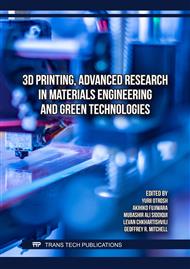[1]
Sharma, A., & Zadorozhnyy, V. (2021). Review of the recent development in metallic glass and its composites. Metals, 11(12), 1933.
DOI: 10.3390/met11121933
Google Scholar
[2]
Jabed, A., Bhuiyan, M. N., Haider, W., & Shabib, I. (2023). Distinctive features and fabrication routes of metallic-glass systems designed for different engineering applications: A review. Coatings, 13(10), 1689
DOI: 10.3390/coatings13101689
Google Scholar
[3]
X. Li, G. Shan, C.H. Shek, Machine learning prediction of magnetic properties of Fe-based metallic glasses considering glass-forming ability, J. Mater. Sci. Technol. 91 (2021) 113–122.
DOI: 10.1016/j.jmst.2021.05.076
Google Scholar
[4]
Suryanarayana, C., & Inoue, A. (2013). Iron-based bulk metallic glasses. International Materials Reviews, 58(3), 131-166.
DOI: 10.1179/1743280412Y.0000000007
Google Scholar
[5]
Liu, C., Wang, X., Cai, W., He, Y., & Su, H. (2023). Machine learning aided prediction of glass-forming ability of metallic glass. Processes, 11(9), 2806
DOI: 10.3390/pr11092806
Google Scholar
[6]
Mastropietro, D. G., & Moya, J. A. (2021). Design of Fe-based bulk metallic glasses for maximum amorphous diameter (Dmax) using machine learning models. Computational Materials Science, 188, 110230.
DOI: 10.1016/j.commatsci.2020.110230
Google Scholar
[7]
Li, K. Y., Li, M. Z., & Wang, W. H. (2024). Inverse design machine learning model for metallic glasses with good glass-forming ability and properties. Journal of Applied Physics, 135(2), 025102.
DOI: 10.1063/5.0179854
Google Scholar
[8]
Bobzin, K., Heinemann, H., Burbaum, E., Johann, L. M., Seßler, J., & Gärtner, J. (2023). Data driven development of iron-based metallic glasses using artificial neural networks [Data set]. RWTH Aachen University.
DOI: 10.1016/j.jallcom.2023.172895
Google Scholar
[9]
F. Ghorbani, A. Kumar, Y. Lee, et al., Thermodynamically-guided machine learning modelling for predicting the glass-forming ability of bulk metallic glasses, Sci. Rep. 12 (2022) 10890.
DOI: 10.1038/s41598-022-15981-2
Google Scholar
[10]
Dataset: Fe-based Bulk Metallic Glass Alloys: Database (up to February 2020) and R code, Mendeley Data, v5, 2020. https://data.mendeley.com/datasets/jy9skrx74g/5.
Google Scholar
[11]
Deng, B., & Zhang, Y. (2020). Critical feature space for predicting the glass-forming ability of metallic alloys revealed by machine learning. Chemical Physics, 538, 110898.
DOI: 10.1016/j.chemphys.2020.110898
Google Scholar
[12]
Xiong, J., Shi, S.-Q., & Zhang, T.-Y. (2020). A machine-learning approach to predicting and understanding the properties of amorphous metallic alloys. Materials & Design, 187, 108378.
DOI: 10.1016/j.matdes.2019.108378
Google Scholar
[13]
Peng, L., Long, Z., & Zhao, M. (2021). Determination of glass forming ability of bulk metallic glasses based on machine learning. Computational Materials Science, 195, 110480.
DOI: 10.1016/j.commatsci.2021.110480
Google Scholar
[14]
Lu, Z. P., & Liu, C. T. (2002). A new glass-forming ability criterion for bulk metallic glasses. Acta Materialia, 50(13), 3501-3512.
DOI: 10.1016/S1359-6454(02)00166-0
Google Scholar
[15]
Wang, X., Zeng, M., Nollmann, N., Wilde, G., Tian, Z., & Tang, C. (2017). Effect of copper addition on the glass forming ability in Pd-Si binary amorphous alloying system. AIP Advances, 7(9), 095108.
DOI: 10.1063/1.4986532
Google Scholar
[16]
Miller, M., & Liaw, P. (Eds.). (2008). Bulk Metallic Glasses: An Overview. Springer.
DOI: 10.1007/978-0-387-48921-6
Google Scholar
[17]
Afflerbach, B., Francis, C., Szlufarska, I., Morgan, D., Voyles, P. M., & Schultz, L. E. (2021). Characteristic Temperature Model for Metallic Glass Critical Casting Diameter [Data set]. Materials Data Facility.
DOI: 10.1016/j.commatsci.2021.110494
Google Scholar
[18]
Ren, B., Long, Z., & Deng, R. (2021). A new criterion for predicting the glass-forming ability of alloys based on machine learning. Computational Materials Science, 189, 110259.
DOI: 10.1016/j.commatsci.2020.110259
Google Scholar
[19]
Yuan, Z.-Z., Bao, S.-L., Lu, Y., Zhang, D.-P., & Yao, L. (2008). A new criterion for evaluating the glass-forming ability of bulk glass forming alloys. Journal of Alloys and Compounds, 459(1–2), 251-260.
DOI: 10.1016/j.jallcom.2007.05.037
Google Scholar
[20]
Wu, X. F., Suo, Z. Y., Si, Y., Meng, L. K., & Qiu, K. Q. (2008). Bulk metallic glass formation in a ternary Ti–Cu–Ni alloy system. Journal of Alloys and Compounds, 452(2), 268-272.
DOI: 10.1016/j.jallcom.2006.11.010
Google Scholar
[21]
Kuball, A., Bochtler, B., Gross, O., Pacheco, V., Stolpe, M., Hechler, S., & Busch, R. (2018). On the bulk glass formation in the ternary Pd-Ni-S system. Acta Materialia, 158, 13-22.
DOI: 10.1016/j.actamat.2018.07.039
Google Scholar
[22]
Santos, F. S., Kiminami, C. S., Bolfarini, C., de Oliveira, M. F., & Botta, W. J. (2010). Evaluation of glass forming ability in the Ni–Nb–Zr alloy system by the topological instability (λ) criterion. Journal of Alloys and Compounds, 495(2), 313-315.
DOI: 10.1016/j.jallcom.2009.10.212
Google Scholar
[23]
Zeng, W., Chen, Y., Li, Q., Li, H., Mu, B., Ye, J., & Chang, C. (2023). Ductile Ni-based bulk metallic glasses at room temperature. Journal of Materials Research and Technology, 26, 2432-2442.
DOI: 10.1016/j.jmrt.2023.08.062
Google Scholar
[24]
Ma, X., Li, Q., Chang, L., Chang, C., Li, H., & Sun, Y. (2017). Enhancement on GFA and mechanical properties of Ni-based bulk metallic glasses through Fe addition. Intermetallics, 86, 34– 39.
DOI: 10.1016/j.intermet.2017.06.012
Google Scholar


